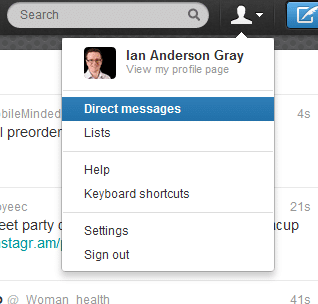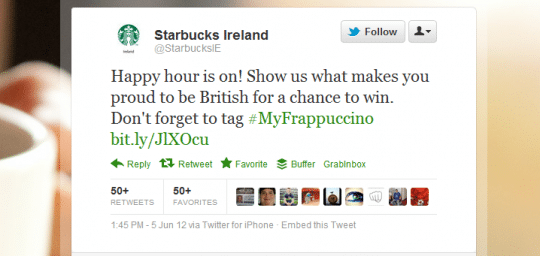12 Social Media & Marketing Techniques to Avoid

(UPDATED- More techniques added!)
It's no secret, just like you, just like everyone, I'm busy. I'm always on the look out for something that is going to make me more productive and faster at I'm working on. With so many social media, marketing and productivity tools and techniques out there which promise to solve all your problems, it's tempting to think that you can switch them all on, go on that luxury holiday and wait for the money to roll in.
Unfortunately, more often than not, you'll just end up annoying people or giving people the wrong impression. Don't get me wrong, I love many of these tools (in particular Buffer, ifttt and Social Oomph) but they need to be used correctly and not as a replacement for engaging with real people.
1. Twitter Automatic Direct Messages

I'm not saying automatic DMs are always bad, they can work sometimes. Beth McShane has an interesting method in which she set up an automatic DM containing the words "Knock Knock". It's hard to resist relying with a "Who's there" tweet and she found more often than not a decent conversation would start.
Sometimes it might be good for a brand to direct message a special offer or discount code- especially if their resources are very thin (they may not have the man power to send individual replies), but I think it's almost always going to be preferable to reply individually. We're all real people (at least I hope so) and we all like interacting with humans not robots!
2. Buying Followers

People who buy followers aren't buying real Twitter followers or Facebook likes managed by real people- they're more likely to be spam robots or accounts who are very unlikely to engage with you. It's all meaningless and unlikely to give you in return. Perhaps most importantly it can very likely get you banned. That means all your hard work to waste. Twitter and Facebook are cracking down on the practice of buying followers. For Twitter make sure you know your Twitter limits and rules and for Facebook read their Facebook page guidelines and rules. It's good to have lots of followers, but just make sure they are real and that you've got them legitimately. They don't all have to be loyal (as this great post entitled "Why You Need Social Media Followers Who Won't Ever Buy" from the Hubspot blog discusses) but 10,000 zombie spam robots isn't going to do you any good.
3. The Eternal Discount

I've seen them all "buy now- limited offer", "Only 1 copy left in sale", "Hurry limited special offer- will end in two days". They're all rubbish- come back in a month's time and they'll say exactly the same. I have no doubt that they do work- a bit, but do they create faith and trust in your brand? The answer is no. I've been put off many times by this kind of marketing- it makes me wary and I'll just avoid. It might create quick one-off sales, but it's not likely to give you repeat business and customer loyalty.
4. Over Post or Under Post

It depends on your audience and the type of content you are sharing, but do be kind to your followers! When you create your social media plan, it's important to work out how often you should tweet and base this on the audience for the particular social channel you are posting to.
It's also important to not leave it too long between posts- if you don't post or tweet for weeks and weeks, you'll get less engagement, lose followers and this can do damage to your brand long term.
5. Always censor criticism

Nestlé was widely criticised for removing negative posts from their Facebook page after negative feedback. I do think it's perfect acceptable to remove offensive comments from a page (such as comments using profanity or words that are likely to cause other people offence), but I do think it's very important to engage with criticisms directly in a postive way. If you turn round a critic publically- they could be your perfect ally and asset. It's likely too, if you respond calmly and positively, that some of your other customers will come to your rescue- I've certainly had experience of this when I have come to the rescue for a service I am passionate about.
You should have a plan for how to deal with negative criticism. State the rules- it's perfectly acceptable not to tolerate abuse or offensive words, but other than that, you should be dealing with criticisms in a calm, polite and honest way. After all, we're all human and make mistakes.
6. Post same content across Multiple Channels and never reply to comments

It's sometimes difficult for individuals and small businesses to manage multiple social media channels- just in terms of time, money and manpower. It's easy to see why using services such as ifttt and ping.fm are so popular- they make it possible to post to all your social networks channels from one status update.
It's vital to remember, that each social network is different- however obvious that sounds. Facebook is very different to Twitter- your friends or fans on Facebook will be different to your followers on Twitter. They both work differently-
- Twitter has hashtags and Facebook generally doesn't
- In Twitter you can refer to people using their Twitter handle where as in Facebook status you tag people.
- Twitter only allows 140 characters, where as Facebook statuses allow up to 63,206 characters.
I don't need to go on- you should get the picture!
I think automatic posting to multiple channels can work- but it does need a lot of thought, and you definitely need to be in the position to respond to comments on each channel. I would definitely recommend against an "always on" automatic syndication (such as all your Tweets posting on Facebook or LinkedIn)- this will just annoy people. You can using services such as Selective Tweets or the LinkedIn Twitter syndication service which will only post to Facebook or LinkedIn if you use a special hashtag. That way, you have full control.
Posting to mutliple networks at one time without then replying to comments is the equivalent of going to a party, shouting at everyone and then immediately leaving. Social media is called social media for a reason- it's supposed to be social- so please be social!
7. Re-share or retweet content that praises you

8. Auto Follow

The problem is that auto-following will mean you'll end up following all sorts- spammers, pornographers, robots and other dodgy types. However, as long as you constantly check and prune the people you follow it can be a good technique. Unfortunately many people don't do this, and they end up with zombie followers.
9. Never plan your posts

- Do you have a plan for your marketing and social media posts?
- Do you have a social media policy and what to do if something goes wrong?
- Do you know how often and when you are going to post?
- Do you know who your audience is?
- Do you know what your success criteria is?
Most of us enjoy chatting on social media channels, but if you don't have a plan then you may well be going nowhere. For more information, see this introduction to Planning your Social Media Implementation by Eli Rose Social Media.
10. Only be interested in selling

Take time to engage with real people, if you do this, you are more likely to build a loyal following who will do part of your marketing for you. This is worth more than its weight in Gold, so don't choose the fast food option!
Let others do the selling for you. You might say to me you have created the best social media tool in the world, but I am more likely to believe that if you have a loyal customer base who say the same thing. Be real, be human, don't over-sell and admit your mistakes. Otherwise, it just puts people off- it certainly does with me. A loyal customer base that is with you for the long term is far better than a quick rush at the start.
11. Posting only a link or no link at all.

Likewise, sometimes people post without any link at all. This is far less bad, as there a many reasons why you won't want to include a link- maybe it's just a question or a quote. However, I have seen updates that are advertising an event or product or website without any links. If you want to direct people to your product/event/website then you'll need to include the link!
12. Duplicate Posts
Some people keep posting the same links and content over and over again. Many spammers and bots use this technique, so you'll just end up being thought of as spam or as an annoyance. Again, thinking about it in real world terms- you wouldn't repeat the same thing to a client or friend over and over again, so don't do it online!
Of course, duplicate posts can work- when done properly. I'm a big fan of the WordPress plugin "Tweet Old Post" that tweets your previous blog posts on a schedule. I am also a big fan of other scheduling tools such as Buffer and Social Oomph. It's just that I think it is vital to not to over do re-posting content. When done properly, it can work well, just think about your followers!
More Techniques to Avoid
Since posting this, I've wanted to share some other techniques we should avoid. Here a few more in addition to the the above 12....
13. Don't Localise Your Content
Just two hours ago from the time I am writing this, Starbucks Ireland (i.e. the Republic of Ireland, not Northern Ireland) posted the following tweet:
Happy hour is on! Show us what makes you proud to be British for a chance to win. Don't forget to tag #MyFrappuccino
— Starbucks Ireland (@StarbucksIE)
(if the above tweet doesn't show, it's because Starbucks Ireland has removed it!)
This is a massive faux pas, because as we all know, the Republic of Ireland is not part of the United Kingdom and is certainly not British, in fact it's a rather sensitive subject. We all make mistakes, but managing social media for two countries from one needs to be managed sensitively. If you are producing content on a social channel that is localised (i.e. specific to one country or location) make sure your content is sensitive to that location, otherwise you could be in trouble. Starbucks Ireland certainly are...!
Update- They apologised. Well, we're all human...!
We erroneously posted to our Irish Twitter page meaning to post to the UK only. Customers in Ireland: We're sorry.
— Starbucks Ireland (@StarbucksIE) June 5, 2012
14. Pretend to be Verified on Twitter
For some reason, there seems to be a rush to try and get verified on Twitter. Verification on Twitter is primarily there for famous people who want their name to be protected (to guard against spoof accounts). Some people seem so desperate to appear to be verified that they'll put a little tick in their name. This doesn't fool people, and in fact it can do you more damage. I tend to avoid following people with a spoof tick in it- it's another technique used by spammers. Just avoid!
Conclusion
These are just some of the techniques that I've seen that I'd recommend avoiding. How about you? Do you agree or disagree with the points I've made above? Are the some that I've missed? Please let me know in the comments below!




Comments